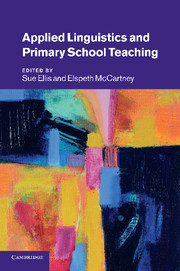Book contents
- Frontmatter
- Contents
- List of figures
- List of tables
- Notes on contributors
- Preface
- Editors' notes and conventions
- Introduction
- Part I Policy and diversity in the twenty-first-century primary school
- Part II The range and focus of applied linguistics research
- Introduction to Part II
- 6 Grammar for designers: how grammar supports the development of writing
- 7 The use of corpus-based approaches in children's knowledge about language
- 8 Words and pictures: towards a linguistic understanding of picture books and reading pedagogy
- 9 From storytellers to narrators: how can the history of reading help with understanding reading comprehension?
- 10 Talk about text: the discursive construction of what it means to be a reader
- 11 Why we need to know about more than phonics to teach English literacy
- 12 Understanding children's reading comprehension difficulties
- 13 Classroom discourse: the promise and complexity of dialogic practice
- 14 Pedagogy and bilingual pupils in primary schools: certainties from applied linguistics
- Part III Empowering teachers and teachers' use of knowledge
- References
- Index
9 - From storytellers to narrators: how can the history of reading help with understanding reading comprehension?
Published online by Cambridge University Press: 26 April 2011
- Frontmatter
- Contents
- List of figures
- List of tables
- Notes on contributors
- Preface
- Editors' notes and conventions
- Introduction
- Part I Policy and diversity in the twenty-first-century primary school
- Part II The range and focus of applied linguistics research
- Introduction to Part II
- 6 Grammar for designers: how grammar supports the development of writing
- 7 The use of corpus-based approaches in children's knowledge about language
- 8 Words and pictures: towards a linguistic understanding of picture books and reading pedagogy
- 9 From storytellers to narrators: how can the history of reading help with understanding reading comprehension?
- 10 Talk about text: the discursive construction of what it means to be a reader
- 11 Why we need to know about more than phonics to teach English literacy
- 12 Understanding children's reading comprehension difficulties
- 13 Classroom discourse: the promise and complexity of dialogic practice
- 14 Pedagogy and bilingual pupils in primary schools: certainties from applied linguistics
- Part III Empowering teachers and teachers' use of knowledge
- References
- Index
Summary
Introduction
Reading can be a sensitive and politicised topic. The debate in the public sphere often concentrates on phonics and the different methods for teaching decoding. Yet it is well known that decoding is not the whole story of the reading curriculum. Efficient decoders can still be poor comprehenders when reading silently, for a variety of reasons (see, e.g., Ricketts et al., this volume; Emmott 1999 [1997]: 9; Cornoldi and Oakhill 1996). Knowledge of comprehension problems that do not result from decoding problems arises from many disciplines, including psychology and linguistics. This chapter suggests that narrative history can illustrate linguistics findings about silent reading comprehension (some of them discussed elsewhere in this volume) in a vivid and accessible way. My own research in the history of reading suggests that style, sentence structure and textual organisation all altered in response to a swift increase in silent reading in the early eighteenth century (Jajdelska 2007). Understanding this historical process can help teachers to recognise comprehension challenges in texts and perhaps to diagnose problems more accurately, showing pupils that silent reading is a complex, comparatively recent and historically rare accomplishment, one of which they can be proud.
The chapter starts with an explanation of an unusual set of conditions which coincided at the end of the seventeenth century to permit, for the first time, a critical mass of readers to move beyond reading as a verbal performance to become fluent, silent readers in childhood.
- Type
- Chapter
- Information
- Applied Linguistics and Primary School Teaching , pp. 118 - 126Publisher: Cambridge University PressPrint publication year: 2011
- 1
- Cited by

